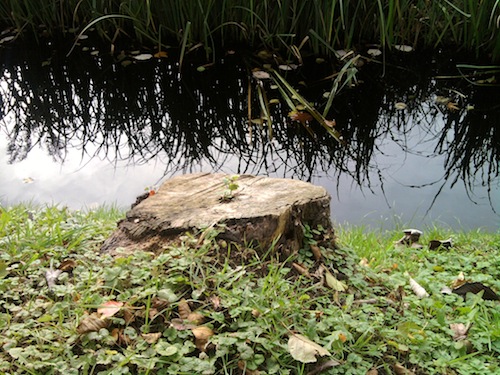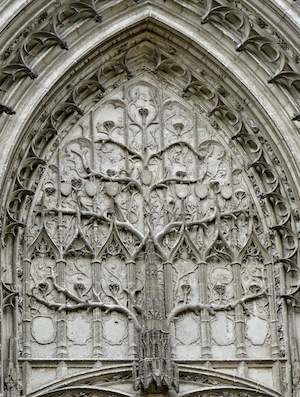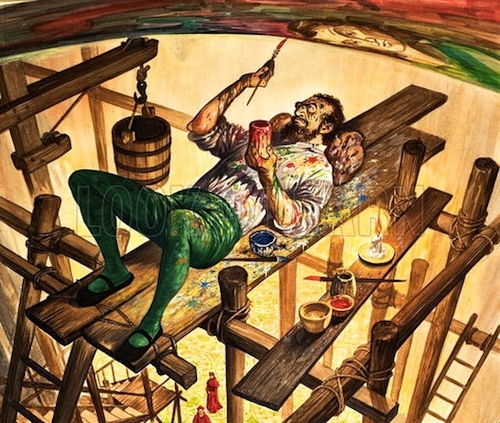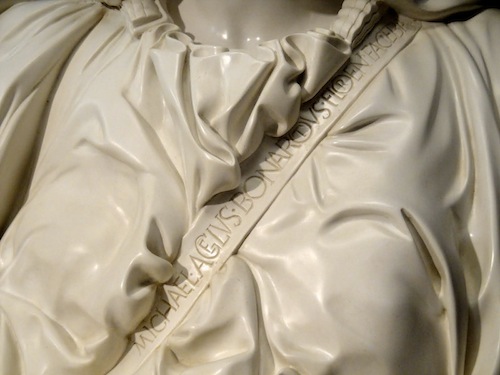In 1498-99 when he was just 24 years-old, Michelangelo (1475-1564) carved his Pieta from one solid rock of Carrera marble. Michelangelo never signed any of his works—except the Pieta.
If you look closely, the sculptor’s signature can be found in a banner /sash across Mary’s chest. It reads:
“MICHAEL*AGELUS*BONAROTUS*FLOREN*FACIEBA.” If one fills in the letters, it reads in Latin “MICHAEL*A(N)GELUS BONAROTUS FLORENTIN(US) FACIEBA(T)” meaning in English “MICHAELANGELUS BUONARROTI FLORENTINE MADE THIS/IT.”

Sixteenth century art historian and contemporary of Michelangelo Giorgi Vasari (1511-1574) in Lives of the Artists tells the tale of why Michelangelo identified himself as the sculptor on the Pieta: “Michelangelo devoted so much love and pains on this work that he put his name on the girdle crossing the Virgin’s breast, a thing he never did again. One morning he had gone to the place to where it stands (originally in Chapel of St. Petronilla in St. Peter’s) and observed a number of Lombards who were praising it loudly. One of them asked another the name of the sculptor, and he replied, ‘Our Gobbo of Milan.’ Michelangelo said nothing, but he resented the injustice of having his work attributed to another, and that night he shut himself in the chapel with a light and his chisels and carved his name on it.”
 Notice in this detail image the left foot of Jesus is resting beside a severed branch. The branch in the sculpture is placed next to Jesus’ foot symbolizing that He “grew” from/is a fruit of that tree. Michelangelo is saying, Jesus of Nazareth’s genealogy (Matthew 1:1-16) stems back to the Old Testament “Branch,” one of the many names for the predicted Jewish Messiah: “In those days and at that time I will make a righteous Branch sprout from David’s line; he will do what is just and right in the land.” (Jeremiah 33:15—626BC)
Notice in this detail image the left foot of Jesus is resting beside a severed branch. The branch in the sculpture is placed next to Jesus’ foot symbolizing that He “grew” from/is a fruit of that tree. Michelangelo is saying, Jesus of Nazareth’s genealogy (Matthew 1:1-16) stems back to the Old Testament “Branch,” one of the many names for the predicted Jewish Messiah: “In those days and at that time I will make a righteous Branch sprout from David’s line; he will do what is just and right in the land.” (Jeremiah 33:15—626BC)
Jesus came from the genealogy, from the family tree of King David. The hewn branch at Christ’s foot, also, symbolizes another name in the Old Testament for the coming Messiah: “a Root of Jesse,” the father of David. “And in that day there shall be a root of Jesse, which shall stand for an ensign of the people; to it shall the Gentiles seek: and his rest shall be glorious.” Isaiah 11:10—c. 700 BC. The metaphor is the Messiah will come from a seemingly dead stump.


Paul, the Apostle to the Gentiles, in Romans 15:12 reiterates in c. 60AD what Isaiah said: “Isaiah says, ‘The Root of Jesse’ will spring up, one who will arise to rule over the nations; in him the Gentiles will hope.’” Jesus identifies Himself with the line of Jesse and his son David: “I Jesus have sent mine angel to testify unto you these things in the churches. I am the root and the offspring of David, and the bright and morning star.” Rev 22:16 KJV

In the 11th century The Jesse Tree began to appear. The Jesse Tree is a tree showing the genealogy of Jesus. It starts with Jesse as its root and goes through all the male ancestors ascending through the branches to Jesus of Nazareth. The Medieval Jesse Tree is the origin of our “family tree” method of chronicling our own ancestors. As the idea caught on, the Jesse Tree was carved in wood, made into stained glass windows, illustrated in psalters, on walls and ceilings of churches and in stone carvings around the door of cathedrals.
Michelangelo, master of sculpting and painting, knew about the Jesse Tree in art, knew the Bible well and studied it thoroughly in order to be able to put such a subtle, arcane reference to Jesus’ genealogy in the Pieta and to place Biblical references in all of his paintings in the Sistine Chapel. When he was 33 in 1508, he started work on the ceiling of the Sistine Chapel in Rome.

Notice this artist (below) has painted the face of Michelangelo painting the ceiling of the Sistine Chapel on his back to replicate Michelangelo’s own painting of himself on the flayed skin of St. Bartholomew.
Michelangelo was a dedicated Christian and imbued his sculptures and his paintings with an intelligent, artistic and reverent mind. He said of his talent: “Many believe—and I believe—that I have been designated for this work by God. In spite of my old age (he lived to be 89), I do not want to give it up; I work out of love for God and I put all my hope in Him.” At Jesus’ death, as immortalized in the Pieta, the stump still does not have a sprout, but after the Resurrection, the seemingly dead Root of Jesse, Branch of David sprouted, grew, flourished, budded, blossomed and is still 2,000 years later bearing fruit.—Sandra Sweeny Silver


